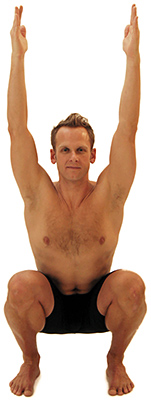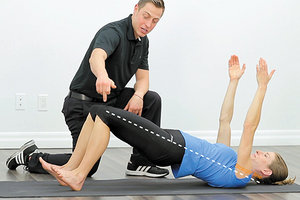Over the years, I have equated what we do as chiropractors during our clinical evaluations to being "diagnosis detectives." In my practice, evaluating an injury like a detective would examine a crime scene has proven to be one of my most successful clinical habits.
On the Case: Knee Pain
If we look specifically at knee pain, we know numerous therapeutic interventions help alleviate the discomfort associated with the plethora of functional and structural disturbances affecting the knee. But should the knee be the main area of focus? When I put my diagnosis detective hat on, I typically see the knee as an area of what I refer to as a "victim zone." At a crime scene, there are victims, criminals and mob bosses, and the sooner you identify the mob bosses who encouraged the criminal actions, creating the victims, the better you will able to solve the case.
I view the human body in the same regard. Many times, the areas of the body our patients come to see us about are really just the victim zones. Unfortunately, too many practitioners focus on victim zones as the target for their treatments. Without taking the time to properly identify the reasons why that area became a victim in the first place, patients can be left with ongoing aches and pains that could have otherwise been resolved.
For example, when looking at the knee, it is one of our largest joints positioned between two of the longest bones in the human body. The knee joint experiences immense transmission of forces through it each day and with each weight-bearing action. Many different criminals can increase the strain experienced by the knee. One such criminal is excessive pronation or supination of the ankle, leading to altered kinetics and kinematics of the knee. Another key criminal is weakness of the hip musculature. The gluteus medius / minimus /maximus can be culprits as well.
Weakness of the gluteal muscles leads to an inability to properly control femoral positioning and most commonly, excessive internal femoral rotation. The uncontrolled internal femoral rotation then leads to excessive torsion at the knee. Torsion at the knee is not a good thing, often resulting in musculotendinous and articular strain or trauma.
The Standing Squat Test
To help identify if this is the case, you can use a simple clinical test called the standing squat. This dynamic movement evaluation helps you identify some kinetic clues as to where the criminals are, so you can better target your therapeutic interventions.
Simply have your patient stand with their feet shoulder-width apart and have them squat as low as they can without letting their heels come off the floor. Did they experience any discomfort? Did they look symmetrical, or did they shift to one side or the other? And if they did shift, did they shift right away or after about 45 degrees of hip flexion? All of these questions help to formulate your clinical hypothesis and build your criminal case.
Many practitioners are beginning to perform dynamic movement evaluations and think of the body as a whole. Let's evolve our clinical practice to now starting to look for the mob bosses. This helps to answer the all-important question, "Why did the criminals behave the way they did?"
 The standing squat test to help identify gluteal weakness causing internal femoral rotation and subsequent excessive torsion at the knee.
In the case of looking at a patient presenting with knee pain, you have put them through the squat evaluation, as well as your other clinical examination strategies, and identified that they have weakness in the gluteal muscles leading to excessive femoral internal rotation. Through your physical evaluation, you may have identified trigger points locally in the muscles, as well as articular dysfunction to be treated accordingly.
The standing squat test to help identify gluteal weakness causing internal femoral rotation and subsequent excessive torsion at the knee.
In the case of looking at a patient presenting with knee pain, you have put them through the squat evaluation, as well as your other clinical examination strategies, and identified that they have weakness in the gluteal muscles leading to excessive femoral internal rotation. Through your physical evaluation, you may have identified trigger points locally in the muscles, as well as articular dysfunction to be treated accordingly.
But one of the most common mob bosses is lack of physical conditioning leading to an inability of the right muscles to do the right thing at the right time. This is extremely common in the gluteal muscles, and is often one of the main contributing factors surrounding knee pain and low back pain, including sacroiliac joint syndrome.
Gluteal Exercises to Help Support the Knee
One of the best ways to support patient care and eliminate the true cause of patients' presenting complaints (the "mob bosses") is through exercise. Exercise is one of the most discussed, yet misunderstood nonpharmacologic management strategies for musculoskeletal conditions. I personally believe there isn't a single patient who couldn't benefit from the targeted use of exercise. In our knee-pain scenario, exercise can help reinstate proper functioning to crucial muscles charged with helping the body perform the movements of life as efficiently as possible.
So, the next time you are treating chronic, recurrent knee pain and have identified the gluteal muscles as being deficient in their capacity, try prescribing gluteal strengthening exercises the patient can perform at home.
Great training exercises for the gluteal complex include the three-point lunge. This is a great exercise not only to work the gluteal muscles, mainly the gluteus medius and gluteus minimus; but also the quadriceps, including the vastus medialis. The three-point lunge also helps promote better balance and postural control when transitioning from one position to the next.
 The gluteal bridge exercise helps activate the gluteal complex while minimizing compressive forces experienced at the knee.
Unfortunately, the gluteus maximus doesn't get enough stimulation with this movement to promote strengthening effects, so you can add a chair step-up to help elicit the proper muscle recruitment. If the patient is having difficulty with movements like the step-up due to knee pain, you can substitute with exercises such as the gluteal bridge with the feet elevated. This will help activate the gluteal complex while minimizing compressive forces experienced at the knee. Once the patient begins to develop the appropriate pelvic stability and you have successfully reduced the localized irritation, you can progress them to the step-up.
The gluteal bridge exercise helps activate the gluteal complex while minimizing compressive forces experienced at the knee.
Unfortunately, the gluteus maximus doesn't get enough stimulation with this movement to promote strengthening effects, so you can add a chair step-up to help elicit the proper muscle recruitment. If the patient is having difficulty with movements like the step-up due to knee pain, you can substitute with exercises such as the gluteal bridge with the feet elevated. This will help activate the gluteal complex while minimizing compressive forces experienced at the knee. Once the patient begins to develop the appropriate pelvic stability and you have successfully reduced the localized irritation, you can progress them to the step-up.
Exercise offers a significant advantage when combined with the therapeutic interventions you currently use. As with any of your techniques, therapeutic exercise can be manipulated to target the specific needs of your patients. The inclusion of therapeutic exercise as an intervention as well as looking at your presenting patients as a diagnosis detective, examining presenting injuries like they are crime scene, will provide you with a significant advantage in the quest to help your patients.
Resources
- Norris B, et al. Hip- and thigh-muscle activation during the star excursion balance test. J Sport Rehab, 2011 Oct 11;
- Baldon Rde M, Lobato DF, Carvalho LP, Wun PY, Santiago PR, Serrao FV. Effect of functional stabilization training on lower limb biomechanics in women. Med Sci Sports Exerc, 2012 Jan;44(1):135-45.
- Baldon Rde M, Lobato DF, Carvalho LP, Wun PY, Presotti CV, Serrao FV. Relationships between eccentric hip isokinetic torque and functional performance. J Sport Rehabil, 2012 Feb;21(1):26-33.
- Reiman MP, Bolgla LA, Loudon Jk. A literature review of studies evaluating gluteus maximus and gluteus medius activation during rehabilitation exercises. Physiother Theory Pract, 2012 May; 28(4):257-68.
Dr. Kevin Jardine graduated from the Canadian Memorial Chiropractic College in 2002 after completing undergraduate studies at the University of New Brunswick. An expert in the field of elastic therapeutic taping, Dr. Jardine focuses primarily on sports therapy and performance, treating and consulting with numerous athletes and teams. He is also president and CEO of Collaborans (www.collaborans.com), which provides interactive digital education for health care and fitness professionals, and can be contacted with questions and comments via e-mail:
.




